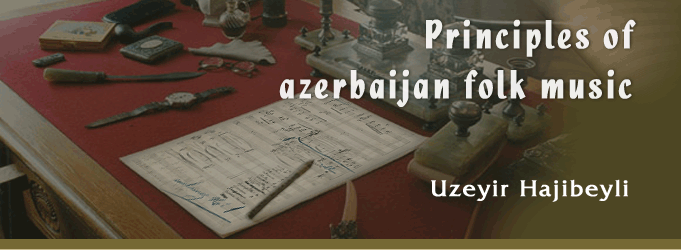

Part one
MAIN PRINCIPLES
IV. PRINCIPLES TO CONSTRUCT AZERBAIJAN MODES
B. Auxiliary modesIn order to form the auxiliary mode "Shakhnaz" it is necessary to combine the tetrachord built on the formula 1 - 1 - 1/2 with a tetrachord from above built on the formula 1/2 - 11/2- 1/2 and combined with the previous one by the second way of combination (mixed one), for example:
This mode does not have its own maye; the melodies composed in this mode may be finished by the formation of cadences on any grade of the upper tetrachord, mostly on the second grade.
In order to form the auxiliary mode "Chargah" of the second type, it is necessary to combine the tetrachord built on the formula 1/2 - 11/2 - 1/2 with another tetrachord from above built on the formula 1 - 1 - 1/2 by the second way of combination (mixed one), for example:The first grade of the lower tetrachord will be the maye of the mode "Chargah" of the second type.
In order to form the auxiliary mode "Saranj", it is necessary to combine the tetrachord built on the formula 1/2 - 11/2 - 1/2, with another tetrachord from above built on the formula 1 - 1 - 1/2 by the second way of combination (mixed one - interval of a semitone), for example:
The last grade of the first tetrachord will be the maye of "Saranj".
1. On the tonics of Azerbaijani modes
The tonics (mayes) of four Azerbaijan modes are also the main tones of the scales. These four modes are:
- "Rast";
- "Shushtar";
- "Bayati-Shiraz"; and
- "Humayun".The tonics of the modes "Shur" and "Segah" are not the main tones of the scale.
The tonic of the mode "Chargah" has the function of the main tone and simultaneously the function of the third and the function of lower quart of the main tones, which is a part of the scale of the mode "Chargah".
In tetrachords built on the formulas 1 - 1 - 1/2 and 1/2 - 11/2 - 1/2 the main tones are the first and the fourth grades of both tetrachords. If the first grade is chosen for the tonic of mode, then the fourth grade has the function of the lower quart of tonic.
In the diminished tetrachord built on the formula 1/2 - 11/2 - 1/2 the main tone is considered to be the second grade of the tetrachord.
Not all the tonics of Azerbaijan modes have the same grades, which subordinate to tonic.
The tonic of the mode "Rast" has the following subordinate grades: lower quart, the sub-mediant, the lower leit-tone, the upper leit-tone, the third, the upper quart and the quint.
The tonic of the mode "Shur" rules the upper leit-tone, the upper quart and the quint. (The lower quart is not used in practice). It does not have the third, the lower leit-tone and the sub-mediant.
The tonic of the mode "Segah" has only the upper leit-tone and the lower third.
The tonic of the mode "Shushtar" is served by the upper leit-tone, the lower third and the lower quart.
The tonic of the mode "Chargah" governs the lower quart, the lower third, the lower leit-tone, the upper leit-tone, the upper third, the upper quart and the quint.
The tonic of the mode "Bayati-Shiraz" has all these in its subordination except for the third.
The tonic of "Humayun" has the same grades in its subordination as the mode "Shushtar". It must be noted that none of the above given tonics have in their subordination a lower quint. It is explained by the fact that tower quint not only is ruled, but rules any tonic as its upper quint (turns it to its upper quint). The assertion "that the tonics of the modes "Shur" and "Segah" have not got all the grades to serve them" could seem strange, for factually, the scales of these modes have all the grades, for example:
Mode "Shur"
Mode "Segah"
In the process of analyzing above scales there could arise a number of questions, namely: is not fa in the scale of the mode "Shur", and sol in the scale of the mode "Segah" the thirds of tonics and so on.
Naturally there exist only one third - that is the so-called major third, the acoustic meaning of which is indicated by the fraction 4/5.
2. The problem of polyphony in Azerbaijan musicThere is a view that if harmony is applied to naturally monophonic Azerbaijan music, all its modal peculiarities will be reduced to zero. It is quite true. Clumsy application of harmony to Azerbaijan melodies may change their character, neutralize the distinction of their modal peculiarities and even make them rough and vulgar. But it does not follow that Azerbaijan music must necessarily remain monophonic. The regular system of Azerbaijan modes and the strict laws to form sensible melodies does not prevent the introduction of polyphony. On the contrary, they submit strong foundation to build big polyphonic forms, based not on the dead (buried by Matheson) gammas, but on the lively and viable modes of Azerbaijan folk music.
The problem of polyphony in Azerbaijan music and its correct solution engages the minds of many composers and musicologists at present. A special work devoted to this problem will be introduced to the musical public in the near future.
The main thing here is that polyphony should be built according to the laws combining logically arranged independent melodies. It should not be principles to achieve correct succession of accords and formation of harmonic cadences, which require changing the structure of modal scales.
Below we give two harmonization of one melody composed on the mode "Shur". It is example of the first attempt to compose in this area.
Melody in the mode "Shur":I harmonization - strict style
II harmonization -folk style
[ MAIN PRINCIPLES: page 1 2 3 4 5 6 7 ]







